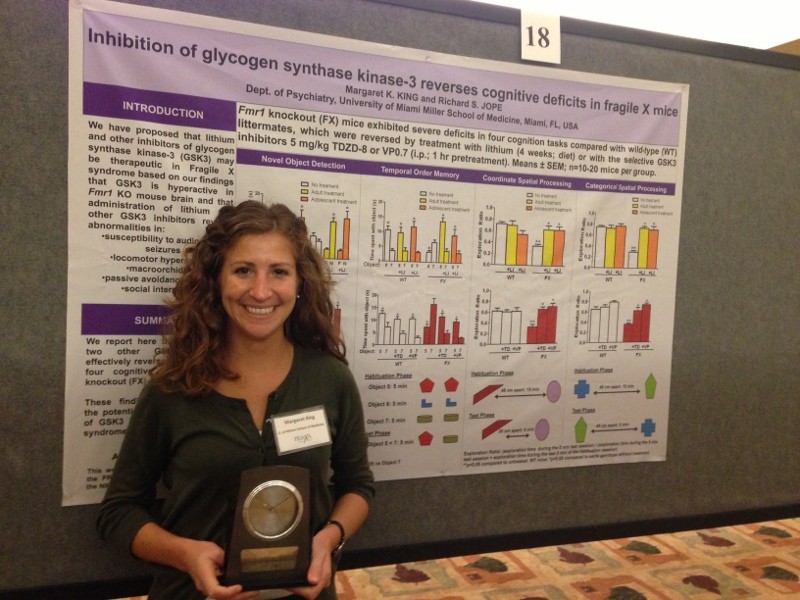Targeting AMP-Activated Protein Kinase Pathway in Fragile X Syndrome
With this grant from FRAXA, Dr. Peter Vanderklish explored AMPK activators to treat Fragile X. Both metformin and resveratrol, found in red wine, are AMPK activators.
Fruit Flies to Model and Test Fragile X Treatments
Boosting cAMP signaling restores memory and fixes brain-signaling defects in Fragile X models, suggesting diabetes drugs like metformin may help.
Analysis of Developmental Brain Dysfunction in Families
No strong behavioral similarities were found between parents and children with Fragile X, indicating family history may not guide clinical trial recruitment.
Effects of Metformin in Fmr1 Knockout Mouse Model of Fragile X Syndrome
Metformin, a safe diabetes drug, activates AMPK to rebalance protein synthesis. FRAXA-funded work investigated its potential to treat Fragile X.
Fragile X Programs at UMASS – University of MA, Worcester
Fragile X Syndrome Behavioral Health Clinic The Center for Autism and Neurodevelopmental Disorders (CANDO) is opening a specialty clinic for individuals with Fragile X Syndrome (under the direction of Dr. Jean Frazier) to evaluate and provide treatment for behavioral challenges.
The Endocannabinoid System in a Mouse Model of Fragile X Syndrome
Fragile X disrupts endocannabinoid signaling. This study in mice demonstrated that correcting it may calm brain hyperexcitability and improve symptoms.
Inhibitors of STEP as a Novel Treatment of Fragile X Syndrome
STEP inhibition reversed behavioral and synaptic Fragile X deficits in mice (Neuropharmacology, 2018), highlighting STEP as a promising treatment target.
Molecular Mechanisms of Cytoskeletal Regulation by FMRP
With FRAXA funding, Dr. Jaffrey linked FMR1 loss to abnormal dendritic spines via RhoA signaling, suggesting RhoA-targeted therapies could help treat Fragile X.
Targeting the Endocannabinoid System in Adult Fragile X Mice
CB1 blockade with rimonabant reversed cognitive, sensory, and seizure symptoms in FXS mice, highlighting the endocannabinoid system as a therapeutic target.
Phase 1 Clinical Trial of Mega Green Tea Extract in Fragile X Syndrome
An early trial of green tea extract EGCG improved cognition in Fragile X. It targets ERβ and reduces overactive PI3K/mTOR/ERK signaling linked to FXS symptoms.
Functional Interplay Between FMRP and CDK5 Signaling
FRAXA-funded work showed CDK5 signaling is disrupted in Fragile X. CDK5 drugs are in development for Alzheimer’s so this pathway offers a promising new FX treatment angle.
Computational Analysis of Neural Circuit Disruption in Fragile X Model Mice
FRAXA-funded researchers used advanced computer models to uncover how FXS brain circuits change and predict which treatments may correct them. Results published.
Synaptic Characterization of Human Fragile X Neurons
Stanford scientists used human stem-cell–derived neurons to show that retinoic acid signaling is blocked by Fragile X, revealing a new pathway to target for treatment.
Bcl-xL Inhibition as a Therapeutic Strategy for Fragile X Syndrome
Fragile X neurons show leaky mitochondria and excess Bcl-xL–driven synapses. Targeting this pathway may restore energy balance and healthier brain development.
Seizures in Fragile X Syndrome and Therapeutic Potential of NMDA Receptor Antagonists
Dr. Wong studies how NMDA and mGluR receptors interact to trigger seizures in Fragile X, revealing NR2B-specific blockers as a promising targeted treatment.
Fragile X Syndrome Treatment Target: MMP-9
Dr. Ethell was awarded FRAXA Research Foundation funding from 2008-2011 and 2012-present. This latest work shows that human Fragile X tissues have elevated levels of the extracellular enzyme MMP-9, as well as an increase in the active fraction of that protein (like most enzymes, MMP-9 can exist in an inactive form which can be switched on rapidly; this kind of regulation is important in most biological pathways.)
Scientists Uncover Trigger for Fragile X Syndrome
A Weill Cornell team discovered that Fragile X stems from a gene being shut off—and a compound that blocks this process may prevent the condition.
Potassium Channel Modulators to Treat Fragile X
FRAXA-backed Yale discoveries tied Fragile X to Kv3.1/Slack channel defects—leading to a partnership with Autifony to develop targeted treatments.
Social Behavior as an Outcome Measure for Fragile X Clinical Trials
FRAXA funding helped identify reliable social behavior tests in Fragile X mice and showed an mGluR5 treatment could improve sociability, guiding future trials.
Translation-Independent Functions of FMRP in Excitability, Synaptic Transmission and Plasticity
Study pinpointed presynaptic calcium dysfunction as the driver of STP defects in Fragile X, and BK channel activation restored normal synaptic signaling.
Glycogen Synthase Kinase-3 (GSK3), Lithium and Fragile X
Dr. Jope found that lithium (at usual therapeutic doses) and investigational GSK3 inhibitors can reverse a number of cognitive deficits in FMR1 knockout mice.
The mTOR Pathway in Fragile X Syndrome
FRAXA-funded research showed that blocking S6K1 in Fragile X mice improves social, behavioral, and physical symptoms.
Matrix Metalloproteinase Therapeutic Treatments for Fragile X Syndrome
Dr. Broadie showed that MMP enzymes disrupt synapse development in Fragile X. MMP inhibitors (e.g. minocycline) improved connectivity and behavior in fruit flies.
Lovastatin Discovery in Fragile X Mice Leads FRAXA to Fund Clinical Trials
FRAXA honored Dr. Emily Osterweil for discovering that lovastatin can correct key Fragile X abnormalities. Her findings were published in Neuron.
























